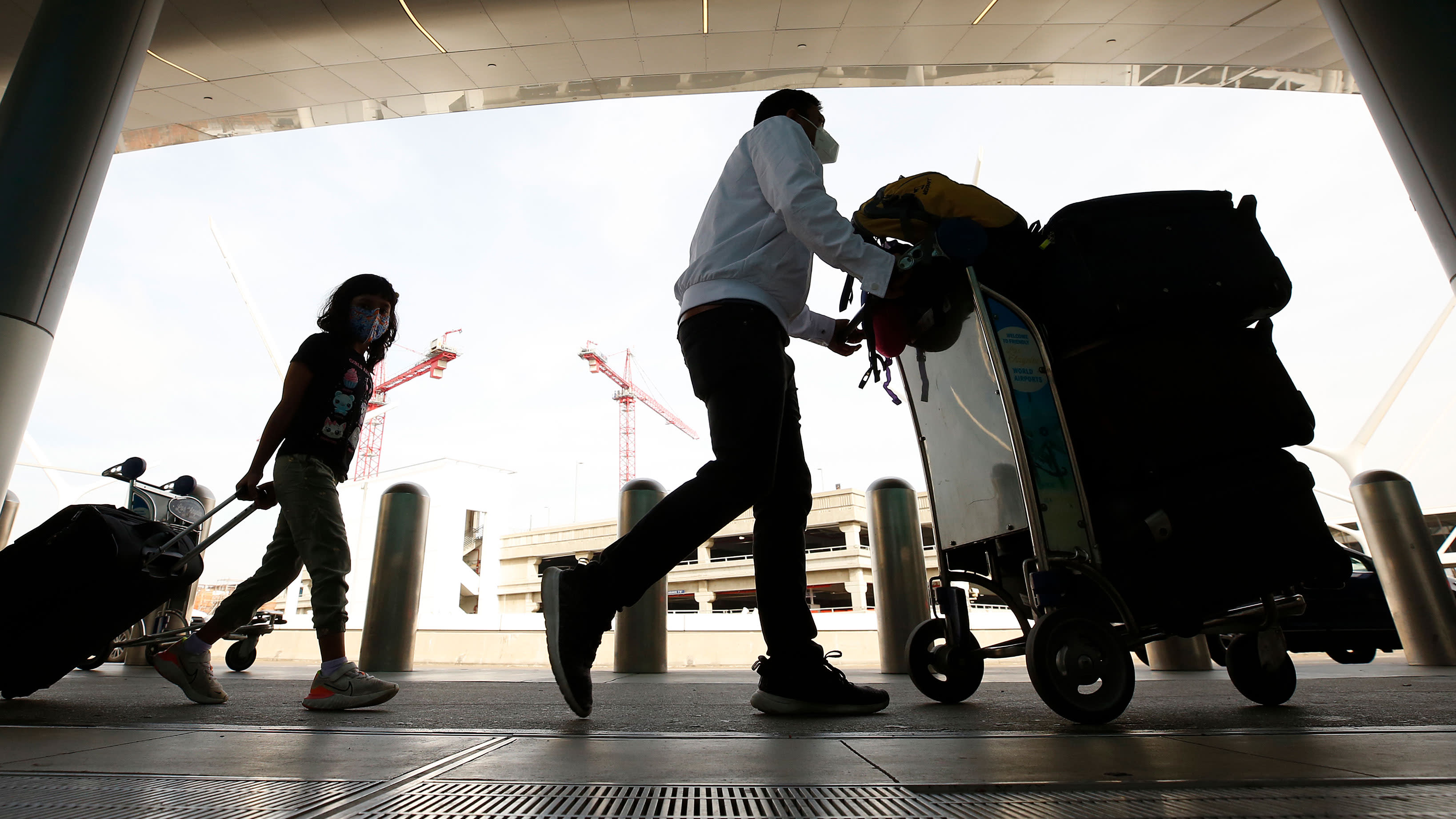Thanksgiving travel surge to test airlines as industry struggles to recover from labor shortages, pandemic

Travelers at Los Angeles International Airport LAX are beating the crowds on Thursday, November 18, 2021, as up to 2 million people are expected to pass through Los Angeles International Airport during the two-week Thanksgiving holiday period that begins today, potentially doubling the number from the same time last year.
Al Seib | Los Angeles Times | Getty Images
Travelers are about to find out whether airlines are prepared for a surge in Thanksgiving passengers.
The Transportation Security Administration expects to screen about 20 million people between Friday and Nov. 28, almost back to 2019 levels. Many of those travelers skipped Thanksgiving trips last year as Covid cases were rising and the Centers for Disease Control and Prevention advised against travel during the holiday.
Both Delta Air Lines and United Airlines said the Sunday after Thanksgiving could be their busiest day since before the pandemic. The airlines forecast this week that between Nov. 19 and Nov. 30, they will fly at least 5.6 million and 4.5 million travelers, respectively.
The increase in travelers is good news for one of the pandemic’s most battered industries. But some airlines have at times struggled to fulfill their ambitious schedules, resulting in high numbers of flight cancellations, most recently at American Airlines and Southwest Airlines.
Getting the balance right is crucial as airlines try to return to profitability, facing challenges from higher fuel prices and new lockdowns in parts of Europe.
Those carriers canceled more than 2,000 flights apiece in less than one-week periods this fall. Delays and cancellations have vexed travelers who have complained about hours-long waits to speak to customer service with hold times sometimes exceeding the duration of their flights.
Staffing struggles
Staffing shortfalls have been a major challenge for airlines, which encouraged thousands of workers to take leaves of absence or early retirement to cut the carriers’ payroll during the pandemic. Now they are racing to hire pilots, reservations agents, flight attendants and other workers. Sick calls have also contributed to disruptions.
Lower staffing levels make it harder for airlines to recover from routine problems like bad weather.
“It’s going to be a busy holiday season,” American Airlines CEO Doug Parker said at The Skift Aviation Forum on Wednesday. “We’re ready for it.”
The carrier expects to fly about 5,000 flights a day during Thanksgiving week with a schedule that’s just 8% below what it flew during that period in 2019.
American is offering flight attendants 50% higher pay for working holiday trips and up to triple pay for those flights if they also meet attendance goals through early January. The Fort Worth-based carrier has also dangled $1,000 holiday attendance incentives to other staff, including at its regional airline subsidiaries.
American Airlines pilots’ union rejected the company’s offer for as much as double pay for holiday trips, arguing the airline needs to make permanent changes to its scheduling.
“The planes should be up in the air, not the schedules,” said Allied Pilots Association spokesman Dennis Tajer.
Southwest, for its part, has offered staff frequent flyer miles wort more than $1,400 for meeting attendance goals over the holidays, through early next year.
Southwest said it would further trim its forth-quarter schedule to avoid disruptions, a measure that American and Spirit Airlines took earlier this year. Its flight crews have complained about exhaustion from grueling schedules. That is on top of the stress of a jump in unruly and violent passenger behavior this year.
Southwest flight attendants’ union said the holiday incentives were insufficient.
“Please know that your Union knows you deserve more and will continue to remind management that if morale is to ever turn around, they need to really step back and listen to their employees once again,” they wrote in a note to members last weekend.
Margin for error
United and Delta have been more conservative about adding back capacity, though they are partially hamstrung by long-lasting travel restrictions compared with more U.S.-focused carriers.
United forecast it will restore 77% of its capacity in the fourth quarter, while Delta forecast 80%, American 89% and Southwest 92%, according to securities filings.
CEOs of United and Delta wrote to customers in recent weeks to assure them that they can book their trips with confidence, touting staffing strategies and customer service tools.
United’s CEO Scott Kirby this week took a swipe at his competitors who have stumbled in recent months.
“We’ve left ourselves a margin of error. At an airline, if you don’t build in a margin of error a little bit of ripple in the system whether its a weather delay one afternoon or high winds one day, if you’re not careful it could cascade into a meltdown,” he said at the Skift conference on Wednesday. “I think some of our competitors eliminated their margin for error in their zeal for getting back to flying a full schedule.”




